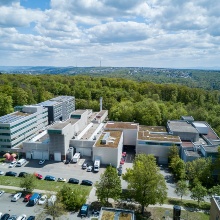History
Prof. Dr.-Ing. André Casal Kulzer has been appointed Univ.-Prof. at the University of Stuttgart as of 01.01.2022 and will take over the chair of Automotive Powertrain Systems as of 01.10.2022; he thus succeeds Prof. Dr.-Ing. Bargende. In the course of the appointment, the chair will be renamed from "Automotive Powertrains" to "Automotive Powertrain Systems" as of 01.10.2022 in order to emphasize the system relevance of the work on vehicle drives even more strongly.
On April 1, 2020, the Institute of Internal Combustion Engines and Automotive Engineering (IVK) was renamed into the Institute of Automotive Engineering Stuttgart (IFS).
Prof. Dr.-Ing. Andreas Wagner will take over the Chair of Automotive Engineering at the Institute of Internal Combustion Engines and Automotive Engineering (IVK) at the University of Stuttgart on 1 March 2019. At the same time, he will become a member of the Executive Board of the Research Institute for Automotive Engineering and Vehicle Engines Stuttgart FKFS, as the professorship and membership of the FKFS Executive Board will be filled by the same person. In both functions he succeeds Prof. Dr.-Ing. Jochen Wiedemann.
With the retirement of Professor Essers in 1998, structural changes were made in IVK and FKFS. In future, three chairs, two of which were donated by the automotive industry, were to be responsible for the Institute's upcoming tasks. Jochen Wiedemann succeeded Prof. Essers as Professor of Automotive Engineering in 1998. In the same year Prof. Dr.-Ing. Michael Bargende was appointed to the Chair of Internal Combustion Engines. In 2004, Prof. Dr.-Ing. Hans-Christian Reuss was appointed to the Chair of Automotive Mechatronics. All three chairs were combined in the Institute of Automotive Engineering (IFS) at the University of Stuttgart. The three professors jointly take over the management of the IFS and are board members of the FKFS; the chair changes every two years.
In 1971 Prof. Dr.-Ing. Ulf Essers took over the Chair of Automotive Engineering and Vehicle Engines at the University of Stuttgart, became Director of the IKF University Institute of the same name and was also a member of the FKFS Executive Board. In addition to his tasks in research and teaching, he planned the construction of the new institute on the university campus in Stuttgart - Vaihingen. In 1975, the foundation stone was laid for the construction of the double institute IKUV, consisting of IKF (Prof. Essers) and IVA (Prof. Huber). After the surprising death of Prof. Huber, the orphaned IVA was rededicated as the "Institute for Technical Combustion ITV". The field of internal combustion engines was affiliated to the IKF, which was subsequently renamed the "Institut für Fahrzeugtechnik Stuttgart (IFS)". The new building was occupied by IFS and FKFS in 1978 and extended by a wind tunnel with a model wind tunnel and a 1:1 vehicle wind tunnel in 1988. Professor Essers founded the new research focus "Noise reduction in motor vehicles and engines". In addition to numerous projects on noise reduction in engines and tyres, several low-noise commercial vehicles were developed and prototyped. Modern engine test benches, state-of-the-art and equipped with the corresponding measurement technology, were the basis for successful engine research. One focus in this research area was the use of alternative fuels. In 1993, the vehicle wind tunnel was upgraded to an aeroacoustic tunnel, making it the most powerful aeroacoustic vehicle wind tunnel in Europe.
After 1945 this tradition was continued by his successor, Prof. Dr.-Ing. Paul Riekert, who in 1949 became full professor of the above-mentioned chair and at the same time director of the FKFS. Paul Riekert took over the reconstruction of the research institute. Already in the 30's and 40's Professor Riekert devoted himself intensively to vehicle dynamics. After the end of the war and reconstruction, he continued his research work in this field and developed the "Stuttgart Friction Meter" to determine the grip of the tyre-road combination. In 1967, the Technical University of Stuttgart was renamed the University of Stuttgart. During this time, the idea was born to separate the research institute from the teaching and research tasks of the chair of the same name. For this purpose, the dual institute IKUV of the University of Stuttgart was founded in 1970/71, which consisted of two completely independent institutes connected by common central facilities. In order to distinguish the fields of work of both institutes, they were called "Institut für Kraftfahrwesen und Fahrzeugmotoren (IKF)" and "Institut für Verbrennungsmotoren und Arbeitsmaschinen (IVA)".
In 1930 Prof. Dr.-Ing. Wunibald Kamm became the first professor to be appointed to the Chair of Automotive Engineering and Vehicle Engines at the then Technical University of Stuttgart. In the same year, Wunibald Kamm founded the private and non-profit "Forschungsinstitut für Kraftfahrwesen und Fahrzeugmotoren Stuttgart (FKFS)" (Research Institute for Automotive Engineering and Vehicle Engines Stuttgart), which served to teach students at the Technical University and was affiliated to the TH Stuttgart as a scientific institute. Wunibald Kamm developed the FKFS into the largest and scientifically leading research institute in the field of automotive engineering. In addition to numerous fundamental studies on motor vehicles and their engines, motor vehicle aerodynamics has always been a special focus. Professor Kamm developed the prototype of an aerodynamically innovative passenger car and built the first 1:1 wind tunnel for motor vehicles.


